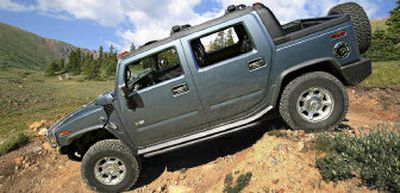Pricey Hummer H2 will go anywhere

One could call this two ways of arriving at the same place.
Last week, we reviewed Honda’s Ridgeline, a diminutive car/truck hybrid whose most prominent feature — aside from its spacious, five-passenger cabin — is a 5-foot bed that grows to 6.5 feet with the tailgate down and bed extender in place.
Today’s entrant is the HUMMER H2 SUT (sport-utility truck), a hulking monster with a — you got it — spacious cabin and an expandable, rubber-lined bed that’s just 3 feet long.
Such is the segmentation of the marketplace; driven by their search for profits to find ever-smaller niches, manufacturers are using different tools to mine the same territory.
The HUMMER story is well rehearsed. The original HUMMER, now called H1 (or Alpha, in car-speak), was a straightforward derivative of a military vehicle popularized during the first Gulf War called the Humvee.
As legend has it, Arnold Schwarzenegger insisted on having one of his own, spurring the commercialization of a military rig.
The H1 was rude, crude and pricey but went anywhere and sold well enough to spawn the H2, which is a different kind of rig entirely. Built by AM General, the company that built and marketed the H1, the H2 is the result of a clever and unique marketing alliance between AM General and that other general, General Motors.
GM now owns the rights to the HUMMER name and HUMMERs are sold through a GM-approved dealer network. While the H1 retains its military bearings, the H2 is fabricated from components requisitioned from the GM parts bin.
Its platform is a buffed-up version of the one underlying Chevy’s Tahoe and the suspension, powerplant and transmission are all of GM origin.
The SUT takes the marriage a step further, borrowing the midgate design introduced on the Chevy Avalanche and refined on Cadillac’s Escalade EXT. With the midgate in its down state and the rear seats folded flat, the bed length effectively grows to 6 feet, although most of it is essentially inside the vehicle.
With the midgate down, of course, the cabin is exposed to the elements, so it is effectively a fair-weather solution.
Unlike its larger sibling, the H2 is a relative pleasure to drive, both on-road and off. It uses an independent front suspension, with torsion bars, and a multi-link rear suspension, with coil springs and solid rear axle, to tame ragged streets and master hairy off-road conditions.
Even with its 17-inch all-terrain tires, surprisingly little road noise infiltrates the cabin and the big, blocky seats offer plenty of support. Four adults will ride comfortably in the SUT, while the regular version includes a jump seat for a fifth rider next to the spare tire in the cargo area.
It’s eliminated in the SUT and the spare moves to the exterior, where it’s mounted on the tailgate.
The high floor, which pays off in spades off-road, turns ingress into something of a chore for the vertically challenged and impacts headroom, but a huge, optional sunroof helps produce an open feel and all five windows (including the midgate window) can be lowered via a single button for the al fresco driving experience.
The interior is suitably dressed out in combat-style accoutrements, including exposed bolt heads, Jolly Green Giant-sized grab handles and an aircraft-style shift lever. Still, the H2 bows to convention with such niceties as dual-zone climate control and a nine-speaker Bose audio system.
It’s easy to look at the H2 and see in it a grown-up’s Tonka Toy, but beyond the faddish, Desert Storm visage is a remarkably capable off-road vehicle. The long wheelbase and short overhangs, combined with that oddly truncated front fascia, enable the H2 to clamber over impediments and ford streams that otherwise would be impassable.
Ground clearance measures 9.9 inches at the differential and, pardon the techie talk, but the break-over angle is a very good 25.8 degrees with the conventional suspension and 26.6 with the optional air suspension. The H2 will handle 60-degree inclines and 40-degree side slopes.
Anti-lock brakes and traction control are standard, as is a world-class traction system that includes dual-range transfer case, multiple drive modes and driver-selectable rear-differential lock feature.
A drive-by-wire throttle system provides power gradually in off-road conditions and more aggressively on-road.
The powertrain comprises GM’s 6-liter pushrod V-8, which makes 325 horsepower and 365 foot-pounds of torque and is hooked to a four-speed automatic. That’s a good bit of juice but the H2 weighs in at 6,400 pounds, so at 10.4 seconds, zero-to-60 is less a sprint than a stroll. Towing capacity is 6,700 pounds.
Needless to say, the elephant in this living room is fuel economy. The H2 is too heavy to be rated under the EPA’s guidelines, but you can expect to get around 9 miles per gallon in town and perhaps 13 mpg on the road. Tough stuff at $2.95/per.
Under way, the steering system doesn’t provide much feel or feedback, but it is accurate and has acceptable on-center feel. This is helpful as, at 81.2 inches, the H2 is the widest SUV in captivity (aside from the H1, natch) and would be a true menace at 70 mph were it a wandering Nellie.
Its width and 43.5-foot turning radius means it is not parking-lot friendly, requiring abundant back-and-forth maneuvering to slip into even the most accommodating space. I didn’t even try to dock it inside my Bat-Cave parking garage.
In today’s world, a rig this big and efficiency-challenged faces a shrinking marketplace. However, if you like the way the HUMMER looks and performs, check back soon, when we drive the all-new H3; it looks like an authentic HUMMER and performs like one, too — for less than $30,000 and 16/19 at the pumps.